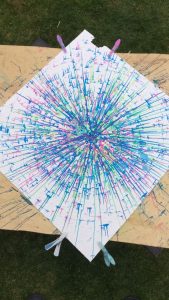Buchloh, B. H. D
(Date of publication)
Gerhard Richter : paintings from 2003-2005.
[Name of Publisher]
This book talks about Gerhard Richter’s paintings he created
from 2003 to 2005. It starts off talking about how Richter began his career and how he developed into exploring different techniques and colour schemes within his work. It also explores why there are no words used in his work’s and how this was influenced by WWII. After the war the use of symbols became more common so this influenced Richter’s work as a German artist.
Being a German artist he was hugely influenced by the war. His influences came from other artists before him, such as Jackson Pollock the process painter, because of his use of colour and paints. Richter began his abstract paintings in 1961 which meant he had to challenge its reputation and credibility at the time.
When asked about being a “postwar German artist”, “your experience as a German after the Second World War and after the Holocaust has inevitably concerned you in your work has shaped you deeply?” by Benjamin H.D. Buchloh, Gerhard Richter replied “Certainly, yes the past has been absolutely formative for me.” This shows that he take’s on thing’s that have happened in the past and this effects his work.

